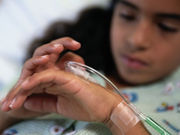Symptoms developed six months after topical ocular glucocorticoid tx for bilateral iridocyclitis
FRIDAY, Jan. 20, 2017 (HealthDay News) — In a case report published online Jan. 19 in Pediatrics, iatrogenic Cushing’s syndrome (CS) is described in a 9-year-old girl who received topical ocular glucocorticoid (GC) treatment for bilateral iridocyclitis.
Daisuke Fukuhara, M.D., Ph.D., from the Kyorin University School of Medicine in Mitaka, Japan, and colleagues present the case of a 9-year-old girl suffering from idiopathic uveitis. She arrived at the ophthalmology department with a complaint of painful eyes, and was diagnosed with bilateral iridocyclitis and started on betamethasone sodium phosphate eye drop treatment.
The authors note that the patient was referred to the pediatric department with stunted growth, truncal obesity, purple skin striate, buffalo hump, and moon face six months after initiation of topical ocular GC treatment. She was diagnosed with iatrogenic CS as her serum cortisol and plasma adrenocorticotropic hormone levels were undetectable. The clinical symptoms of CS were improved after the doses of topical ocular GC were reduced. On genetic analysis, the patient was found to have a single heterozygous nucleotide substitution in the 3′ untranslated region of the NR3C1 gene.
“However, additional investigations are required to determine if our findings can be extrapolated to other patients,” the authors write. “In conclusion, clinicians should be aware that even extremely low doses of topical ocular steroid therapy can cause iatrogenic CS.”
Full Text (subscription or payment may be required)
Copyright © 2017 HealthDay. All rights reserved.








